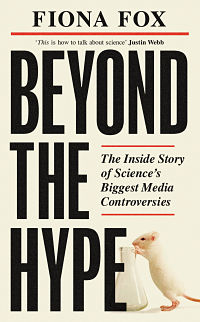The Science Media Centre at 20
The UK’s Science Media Centre (SMC) is an internationally admired, and occasionally emulated, model for facilitating interactions between the science community and the cadre of specialist journalists covering innovations in science and medicine. Its team of press officers offer these reporters a one-stop shop for expert commentary on current research and help scientists to craft their public statements in ways that journalists can work with. The director, Fiona Fox, has now published an account of the Centre’s experiences since it was founded in 2002, in the wake of the perceived failure of scientists to communicate the safety and benefits of GM crop technology in the face of opposition from environmentalist groups.

Beyond the Hype is a compelling read, as the author describes her interactions with scientists, journalists, politicians, and press officers, for both universities and government. The SMC’s independence and credibility have, at times, been hard won and its Director clearly has a few scars from the experience. She has charted a course between coaxing scientists to speak publicly about their work, while managing the growing desire of university press offices to hype research and of government press offices to silence it, especially when politically inconvenient. Her frustrations are obvious but enlightening. There are also some episodes that are unintentionally revealing about the deafness of senior scientists to external concerns about the responsiveness of their profession to a changing social context: the elderly author of ill-considered joking remarks about gender at a conference in Japan finds himself ghosted by the time he is back in the UK – and bewildered by the consequences.
But this case also hints at the limitations of the model. The SMC is founded on a 1990s view of science communication, that the lay public suffer from a deficit of knowledge which can be corrected by accurate and rational reporting. Within this framework, it has achieved a great deal through its network of media connections and reputation for accuracy, responsiveness and impartiality. What it was not intended to do was to communicate society to scientists. The SMC will try to manage reputational injury but not to prevent it. More recent developments in science communication, through public engagement and public dialogue to co-production, have not been defined as part of its mission.
In some respects, this explains the elite support that it has enjoyed. While scientific leaders have professed a commitment to a more collaborative relationship with society, the experience of the COVID pandemic has revealed the superficiality of these statements. Patrician attitudes have re-emerged, denying that scientific research is a social world populated by humans with the same motives, fears and anxieties as anyone else.
This is not a criticism of the SMC, which does very well what it is charged to do. It is, however, a question about the mission itself. The SMC has only a limited engagement with the research community in science and technology studies (STS) and the questions that it asks about science communication, science policy and the social organization of science. In promoting science to society, it perpetuates the narrative that scientists like to tell about themselves, that they are more authoritative, disinterested and rational than other humans.
The problems with these claims – which STS researchers have questioned since the 1930s – have become evident during the pandemic. The book’s final chapter discusses the challenges of presenting fast-moving science when it is not clear whose expertise is most relevant, whether elite views are well-founded and what other agendas, both personal and professional, underlie public statements. SMC’s job is much easier when there is a firm scientific consensus. During the pandemic, it has been a beacon for accommodating a degree of diversity and dispute within a broad framework of respect for evidence. Elite positions have been scrutinized, even if this has, at times, led to challenges and questions about why X or Y are being allowed a voice.
Pandemics, though, are as much societal as biomedical or public health phenomena. SMC has often found itself sharing assertions about society by biomedical or behavioral researchers with no epistemic authority in that field. It has not been able at least to juxtapose these with evidence-based commentary from more relevant disciplines, whether in the social sciences or humanities. Would we have had a more proportionate policy response, for example, if SMC had promoted historians of medicine pointing out that this was not, by their standards, a particularly severe pandemic in terms of mortality?
The Science Media Centre is a remarkable innovation and is rightly celebrated in this book. Fiona Fox and her team have done an exemplary job in improving the quality of interactions between British scientists and the British media. International envy is well-justified. I have no doubt that my STS colleagues will mine the text for case studies. However, after 20 years, it might be time to consider whether there is space for a more radical mission that engages with the social science of science and encourages SMC’s scientific patrons to think more systematically about how society might see them.
Robert Dingwall is on the SMC expert database and occasionally invited to comment on the societal aspects of biomedical or public health research.


































































































